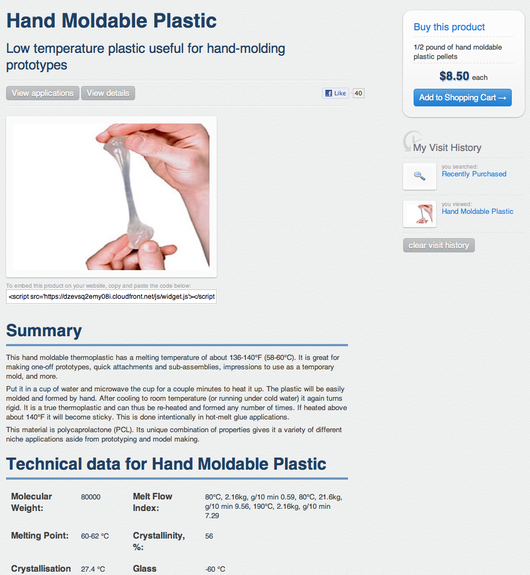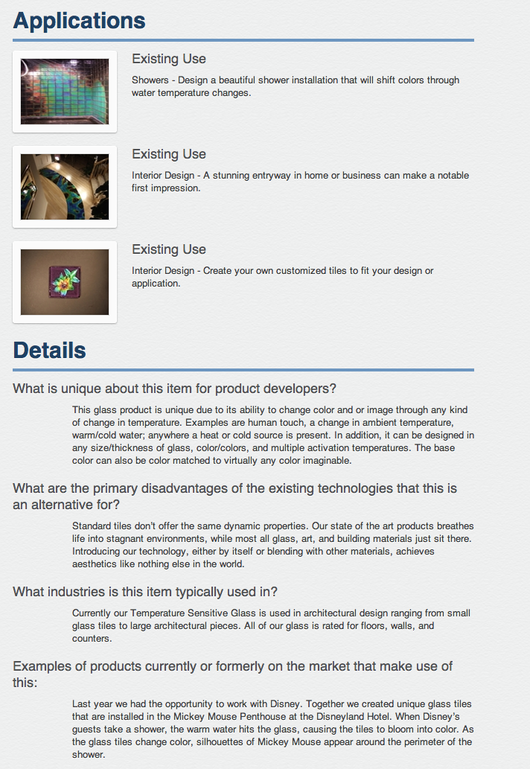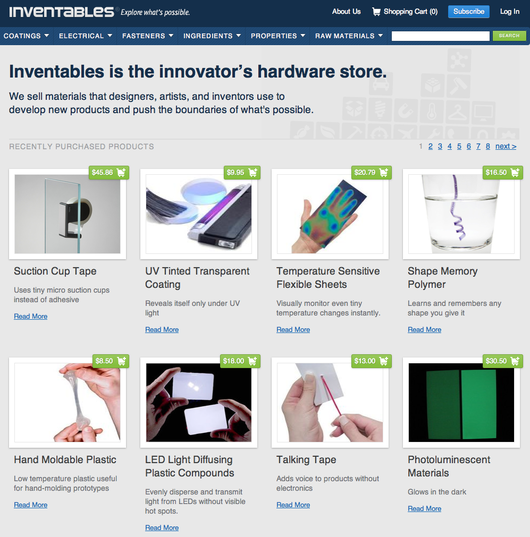Inventables, “the innovators hardware store,” specializes in materials that designers, artists, and inventors use to develop new products and make new things. The site is filled with neat stuff but faces a tough challenge: selling things that people have never seen before and don’t know they want/need. The site responds by diving deeper with product descriptions, photography, sample usage, etc. Here’s the product page for Hand Moldable Plastic at Inventables:

It’s interesting to see how this page differs from other sites that sell moldable plastic. Elsewhere, you just see a picture of the product in a jar. Inventables shows it in use by human hands.
Elsewhere, it’s called simply “Moldable Plastic.” Inventables adds a helpful descriptor, calling it “Hand Moldable Plastic: Low temperature plastic useful for hand-molding prototypes.”
Elsewhere, the only specs listed are the size of the jar it comes in: “3.5×3.5×3.8 inches; 13.8 ounces.” Inventables gives you stats on the actual substance, including Crystallisation Temperature, Viscosity, Melt Flow Index (whatever that is).
 That level of detail, combined with a curated product mix, is how the site competes with bigger retailers. According to Zach Kaplan (right), CEO of Inventables, the goal is to inspire customers. “Part of making it accessible is making it inspiring. It has to have that design aspect to it,” says Kaplan. “Otherwise it looks like any other retail site and we’re just selling a jar of resin pellets.”
That level of detail, combined with a curated product mix, is how the site competes with bigger retailers. According to Zach Kaplan (right), CEO of Inventables, the goal is to inspire customers. “Part of making it accessible is making it inspiring. It has to have that design aspect to it,” says Kaplan. “Otherwise it looks like any other retail site and we’re just selling a jar of resin pellets.”
Since it’s selling a world of foreign objects, an environment tailored to discovery is key for the site. Kaplan says, “If you know what you want, then yes, you can go to Amazon and type it in and get to it. But if you don’t know what you want, that jar is not helping you.”
That’s why you get things like scientific specs and in-use photography at the site. “Our pictures are very expensive,” explains Kaplan. “I guarantee you we’re paying a lot more for pictures than other sites are paying. We’re trying to ignite your imagination. And to make you think, ‘What could I do with this?’ At other places, it’s more of a catalog than a place to go explore.”
Inventables also gives examples of how others are using each product in order to spark ideas. For example, the Applications section for Temperature-Sensitive Glass (below) shows how people have used it in shower installations and interior design. The Details section explains what’s unique about the product, why it’s better than alternatives, and more.

It’s a good lesson for anyone who’s trying to compete with bigger competitors. If you’ve got a smaller product mix, you can obsess over these details in a way that big guys can’t. Customers respond to that.
A rude awakening
Inventables prides itself on challenging the status quo and selling to customers who feel the same way. “A lot of big companies just aren’t set up to get stuff done. I think it’s just now because of stuff like this and Kickstarter, it’s starting to get more visibility,” explains Kaplan. “Things like Kickstarter are starting to be a rude awakening to corporate America because the risk at those places is always someone deciding ‘We’re gonna kill this idea.’
“With Kickstarter, the designer comes up with the idea. Then they can put it on there. The rendering only takes your time. And the customers are voting.”
One example Kaplan points to is Craig Diamond, founder of Diamond MMA, which has set a new standard in UFC protective gear. “Craig went on our site and ordered every single padding material that we have,” according to Kaplan. The shorts Diamond designed — which also used other Inventables products like this cushioning gel — offer protection unrivaled by any other product on the market.
Here’s a video that shows Diamond putting the shorts to the test.
Kaplan feels this DIY product movement is just getting started. “I think a lot of that stuff is getting disrupted right now,” he says. “And because of that more people are realizing, ‘Man, I can do that too.’ I don’t think five years ago, or even three years ago, those guys would have done it because there was no hope.”

Inventables.com home page.
Related: How Kickstarter Became a Lab for Daring Prototypes and Ingenious Products [Wired]

Anonymous Coward
on 22 Mar 11What the heck is this blog post about?
I’m so dang confused.
If I’m understanding the intent of this post correctly, wouldn’t this post typically just be a 2 sentence post on 37svn stating how Inventables has taken a creative design approach to selling ordinary & boring products. (And then just provide a link to the site and not write up a huge post on this).
Anonymous But Not Cowardly
on 22 Mar 11@Anonymous Coward: Who pee’d in your Cheerios?
David Andersen
on 22 Mar 11Thanks – I’ve been looking for this sort of place!
Anonymous Coward
on 22 Mar 11@Anonymous But Not Cowardly
37signals has. The past two weeks has been horrible writing on their part, which they claim to pride themselves on.
No worries, I’ve just unsubscribed from the RSS feed for 37svn – so I won’t be around much anymore.
Nathan
on 22 Mar 11Nooooooooooooooooo!!!!!!!!!! Anonymous Coward don’t go!! What will we do without you? I’m overwhelmed by the loss…
stephen
on 22 Mar 11Good post. As a webmaster this is so true if you are a niche player. Never seen it said before though.
S
Doug
on 22 Mar 11We had Inventables at my old job and it basically boiled down to the lazy person’s research method. As an engineer in a certain field, if you are staying current in the field, but reading magazines and journals, attending trade shows and communicating with suppliers, you will see everything that Inventables has to offer. They don’t provide anything new, and the cost is not cheap! They don’t actually sell anything, Inventables is just a conduit between suppliers and users. Some of the suppliers would limit their samples and wouldn’t even talk with you unless they felt you were “qualified”, especially if their samples were expensive.
The one nice thing that Inventables did offer was where you could log on to your user account within your company and start a project. Then anyone else from your company with a login could see that project and the types of items you were working with or looking at.
Overall it went gangbusters for the first couple months, then tapered off until nobody was using it any more since we already knew about 90% of the items. The shipping of the samples also starts to catch up with you if you don’t set up a regimented process to consolidate your samples within your group. I wouldn’t recommend it to anyone unless they were lazy and had a lot of spare cash to blow.
David Andersen
on 22 Mar 11@Doug – consider the utility of such a site for people who are not engineers but have hobby or other professional (architects for example) interests that would benefit from these materials. I have zero time to stay current in the dozens of fields that these materials span, but I can make use of some of these, if for nothing else than to stimulate new ideas. Eureka!
EH
on 22 Mar 11Never heard of that happening before.
One thing I thought was missing from this was a discussion about how to make a case for more expensive production (“capital intensity,” I guess) to the people who’s job it is to keep the burn rate down. I suspect this, more than customer laziness or liquidity, is the reason why so many web stores suck. Also, were there any rights issues in creating new product pictures?
simple
on 23 Mar 11I love how they make complicated science stuff and make it seems like simple usable toys.
Zach Kaplan
on 23 Mar 11Hey Doug- It’s Zach from Inventables. I wanted to make one point of clarification to your comment. We’ve changed or business model from the one that you remember. We’ve posted all the information that used to be behind login and password for free on the internet and now sell each material in small quantities. For example the hand moldable plastic mentioned in this blog post is currently selling for $8.50 per half pound. You can go to our site and order whatever you want with a credit card. We are stocking inventory of everything on the site and we ship it from our office as orders come in. This approach is much less expensive than it used to be and makes it accessible to individuals, startups, as well as big companies. We are not signing up any new customers to the subscription service anymore but we do still have the idea of the week email however now it is free to sign up. You can think of the new model as an online hardware store. We plan to continue to add more products for sale that will help customers actually build prototypes.
Calin
on 23 Mar 11Excellent post!
Tim Jahn
on 23 Mar 11Love what Zach and his team are doing at Inventables. Really smart guy too.
Shark
on 23 Mar 11Nice website and product presentation. I enjoy these blogs and design examples. Thanks
Michael S
on 23 Mar 11He pays $4 for every picture.
John Nelwand
on 25 Mar 11I like what Inventables has done from a marketing standpoint with their site. Instead of arguing about the utility of the product, look at the marketing. They have put themselves in a position where they are not just marketing to those people who are already knowledgeable about materials. Its not about the materials, its about how the materials are used. This type of marketing, IMO, puts them in front of more potential users than the typical materials-based company would put them in front of.
Marketing Gal
on 28 Mar 11The picture is good. I like what simple says, they make it look like a toy. Very cool, makes me wanna run out and get some!
This discussion is closed.